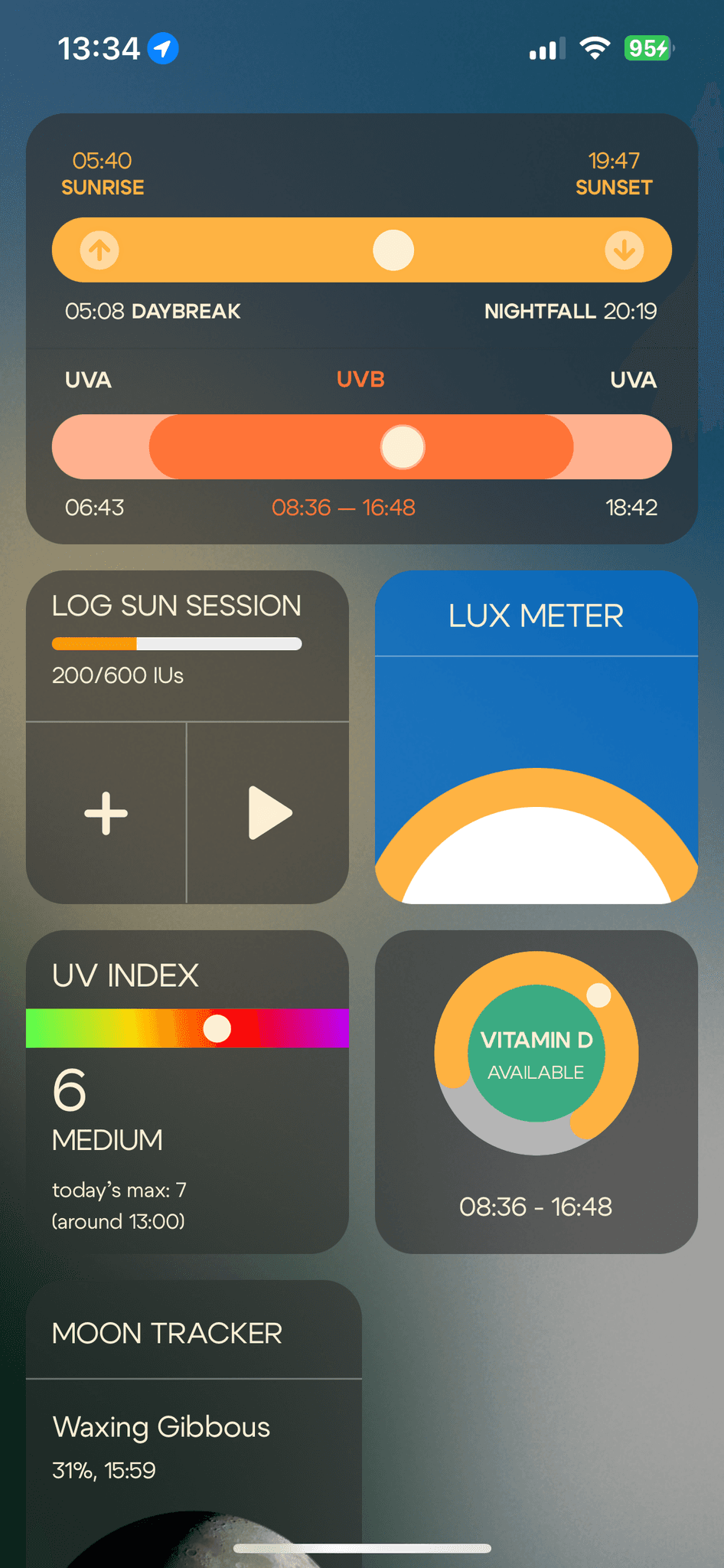
Daybreak - Sunrise, UVA, UVB, Sunset - Daybreak & Nightfall
Understanding why these time periods are important for your health & why we tell you when they happen in the MyCircadianApp:
Let’s break down the benefits of each of these times & why we want to maximize them on our journey to optimal mitochondrial, hormonal & mental health!
Daybreak (sun below 0 degrees)
At Daybreak there is an abundance of Red & Infrared light available. Are you familiar with Red light therapy? The benefits of these 2 wavelengths of light are excellent to reduce inflammation, support mitochondrial health & increase cellular water up to 4-fold (see over 10,000 studies on red light light therapy - https://docs.google.com/spreadsheets/d/1gHPff2thoYpB8gmz6bzG_XsAa43pUdEIwfqStpzuYUk/edit#gid=0
There is also less UV interference & you can gather more electrons from grounding - https://earth-planets-space.springeropen.com/counter/pdf/10.1186/s40623-022-01656-9.pdf
If you can’t make it outside for daybreak - that is OK! It is helpful & will be supportive of your mitochondria - but not required for optimal circadian health. Red and infrared are available as long as the sun is up (so you can get them all day long).
Sunrise (sun between 0-10 degrees)
Sunrise provides a unique balance of red and blue light—something artificial light cannot replicate—that activates the HPA and HPG axes, signaling the mitochondria to produce pregnenolone, the precursor to all steroid hormones, including cortisol, helping to energize us for the day ahead.
As the sun rises, the intensifying red light mimics the benefits of infrared, while also displacing nitric oxide from step 4 of the mitochondrial electron transport chain, enabling the production of more deuterium-depleted water and ATP to power us through the day.
Blue light begins to come on the horizon in the perfect amount to tell your brain to begin cortisol production. This serves as an adaptogen for those who have early morning cortisol that is too high & for those who have early morning cortisol that is too low.
Light Perception by the Eyes: When the sun rises, the intensity and wavelength of light change, with early morning light containing more blue light. Special light-sensitive cells in the retina, called intrinsically photosensitive retinal ganglion cells (ipRGCs), detect this blue light.
Activation of the Suprachiasmatic Nucleus (SCN): The ipRGCs send signals to the brain's master circadian clock, located in the suprachiasmatic nucleus (SCN) of the hypothalamus. The SCN is responsible for regulating your body's daily rhythms, including hormone production.
The exposure to morning light, particularly during sunrise, helps synchronize this cortisol release with the day-night cycle, promoting a healthy circadian rhythm. If you don’t get adequate light exposure in the morning, your cortisol levels may not rise appropriately, which can lead to fatigue, disrupted sleep patterns, and hormone imbalances.
Studies/Education:
Circadian rhythm has a bidirectional interaction with almost all metabolic processes - https://karger.com/anm/article/74/4/322/51852/Effect-of-Circadian- Rhythm-on-Metabolic-Processes
Circadian clock disruption impairs lipid and glucose metabolism - https://www.ncbi.nlm.nih.gov/pmc/articles/PMC7002226/
How long should you be outside for sunrise for benefits? The longer the better, but between 5-20 minutes will give you brain & hormonal benefits. Remember - light exposure is cumulative, so if on Monday you only have 5 minutes, but on Tuesday you have 20 minutes - this will even out & still provide benefits over time. Consistency is key, so aim to get outside daily, even if the duration varies. Every minute counts towards improving your circadian rhythm, boosting your mood, and supporting hormonal balance.
UVA rise (sun between 10-30 degrees) - available year round
The next window of time you want to prioritize is UVA in the morning, and here’s why:
UVA is available year round (unlike UVB), and UV light stimulates POMC - leptin melanocortin pathway; POMC is a biophysical gene (also known as a brain protein).
Exposure to UVA light after sunrise stimulates the production of neurotransmitters & neurohormones essential for regulating appetite, metabolism, motivation, and focus.
Maximizing serotonin & dopamine production in the morning through UVA light exposure can support leptin function, leading to improved fat burning and overall metabolic health.
UVA light triggers the production of neuropeptides that support appetite regulation, particularly in individuals struggling with leptin resistance.
Incorporating UVA light exposure into your daily routines can benefit from sunlight's healing properties and metabolic advantages while minimizing the risk of overexposure.
POMC is a precursor protein of several neuropeptides, including adrenocorticotropin (ACTH), α-melanocyte stimulating hormone (α-MSH) and β-endorphin (β-END).
POMC cleaves and produces the peptide beta endorphin ("runners high", lowers pain)
РОМС cleaves and produces the peptide - АСТН (regulates stress/Inflammation - and ultimately regulates cortisol and androgen production)
POMC cleaves and produces - alpha, beta & gamma MSHs (stimulates melanin, regulates appetite, and alpha-MSH directly influences thyroid activity, specifically TRH and T3. This pathway also intersects with leptin, forging a link between metabolic regulation and thyroid health.)
POMC cleaves and produces Lipotropins (improves fat burning)
During UVA light: Aromatic Amino Acids in your eyes capture photons of UVA light and transform:
Aromatic Amino Acid Tryptophan converts into serotonin (groggy to happy) & this serotonin is converted into that night’s pineal melatonin.
Aromatic Amino Acid Tyrosine converts into dopamine ( increased motivation)
Aromatic Amino Acid Tyrosine converts into norepinephrine (better focus/fat burning)
We also make melanin in UVA light:
Immediate Pigmentation: UVA rays, which penetrate deeper into the skin than UVB, can cause immediate pigmentation by oxidizing existing melanin. This leads to a darkening of the skin almost immediately after exposure to UVA light.
Delayed Melanin Production: UVA light also stimulates the production of new melanin, but this occurs over a longer period. Melanocytes (the cells that produce melanin) are activated to create more melanin as a protective response to DNA damage caused by UVA rays. This newly produced melanin can provide some protection against further UV exposure, though it is not as effective as the melanin produced in response to UVB.
Protection: Both UVA and UVB light contribute to tanning, but UVB is more effective in triggering the production of new melanin. Melanin acts as a natural sunscreen by absorbing and dissipating UV radiation, protecting skin cells from DNA damage.
Studies/Education on UV light:
Leptin Melanocortin pathway - https://www.ncbi.nlm.nih.gov/pmc/articles/PMC6500576/
How UV light touches the brain and the endocrine system - https://www.ncbi.nlm.nih.gov/pmc/articles/PMC5905393/
Impact of UV exposure and improvement of metabolic function https://www.ncbi.nlm.nih.gov/pmc/articles/PMC6719744/
UVA Light and nitric oxide production - https://www.ncbi.nlm.nih.gov/pmc/articles/PMC5593895/
Exposure to solar ultraviolet radiation limits diet-induced weight gain, increases liver triglycerides and prevents the early signs of cardiovascular disease in mice - https://www.ncbi.nlm.nih.gov/pmc/articles/PMC6719744/
Molecular eyes: proteins that transform light into biological information - https://www.ncbi.nlm.nih.gov/pmc/articles/PMC3915823/
Sun Exposure and Its Effects on Human Health: Mechanisms through Which Sun Exposure Could Reduce the Risk of Developing Obesity and Cardiometabolic Dysfunction - https://www.ncbi.nlm.nih.gov/pmc/articles/PMC5086738/
How much time outside? The more the better! However - if you had to choose one window of time in the morning to spend MORE time outside - UVA rise/UVA window is extremely powerful. Always remember - something is better than nothing & consistency over perfection!
UVB - when the Sun is above 30 degrees in the sky
Many argue that for Vitamin D synthesis - the UVI should be above a 5 or 6, but this also depends on Fitzpatrick skin type & mitochondrial haplotype.
UVB is where your body makes vitamin D, and you will notice with the MyCircadianApp that many locations will only have UVB during the summer/warmer months.
We will talk about some of those UVB benefits below - but here is a blog post that explains the MANY benefits of sunlight beyond Vitamin D (even the benefits of sunlight in the shade) - https://www.sarahkleinerwellness.com/blog/are-there-benefits-of-sunlight-beyond-vitamin-d
UVB exposure has metabolic benefits like releasing nitric oxide and alpha MsH, leading to anti-inflammatory effects and acting as an appetite suppressant.
When you expose your body to UVB, here are some more widely known benefits:
Vitamin D Synthesis: The most well-known effect of UVB exposure is the production of vitamin D. When UVB rays hit the skin, they convert 7-dehydrocholesterol (a compound in the skin) into previtamin D3, which is then converted to active vitamin D3. This process is crucial for bone health, immune function, and hormone regulation.
There are dozens of vitamin D metabolites that are made in response to UVB (D3 is the only one most doctors measure), and there are some alternative viewpoints when it comes to what our levels should be.
Here’s a great video to explore this topic deeper: Jim Stephenson Jr & Vitamin D - https://youtu.be/5yK91h6bt9gMelanin Production: UVB exposure stimulates the production of melanin in the skin, which provides some protection against further UV damage by absorbing and dispersing UV radiation. This is part of the skin’s tanning response.
Hormonal Influence: UVB light plays a role in regulating certain hormones, including beta-endorphins (which are associated with mood enhancement and a sense of well-being) and nitric oxide (which can influence blood pressure by causing vasodilation).
Metabolic Health: UVB can also act as a dietary restriction memetic by targeting mitochondrial bioenergetics.
Researchers have found that after an initial stress response, UVB light had a positive effect on the production of new mitochondria, similar to what happens in the body during calorie restriction. In simpler terms, UVB light triggers a helpful reaction that makes the system stronger.
They also discovered that UVB exposure on the skin of mice led to fat being burned in a way that mimicked the effects of fasting, causing fat cells to shrink. https://doi.org/10.1101/2024.03.05.583543Suppression of Immune Responses: UVB exposure can suppress certain immune functions, especially in the skin. This can be beneficial in controlling autoimmune and inflammatory skin conditions like psoriasis, eczema, and vitiligo by reducing overactive immune responses that cause inflammation.
Enhanced Skin Barrier: UVB light can enhance the skin's barrier function, which helps protect against pathogens and supports overall immune health. A stronger skin barrier reduces the risk of infections entering the body through the skin.
Induction of T-regulatory Cells: UVB exposure promotes the production of regulatory T cells (Tregs), which help control immune responses and prevent autoimmunity. Tregs help maintain immune tolerance, ensuring that the body doesn't attack its own tissues unnecessarily.
Anti-inflammatory Effects: UVB light can trigger the release of anti-inflammatory molecules, helping to dampen chronic inflammation. This effect can be beneficial for individuals with inflammatory conditions and can support overall immune balance.
UVB light exposure reduces levels of C reactive protein: a marker of inflammation - https://www.ncbi.nlm.nih.gov/pmc/articles/PMC6719744/
Time to stay out in UVB? Not medical advice & for informational purposes only: The Vitamin D timer in the MyCircadianApp can help you gauge how long you can stay out in the sun & avoid over exposure by taking metrics such as your Fitzpatrick skin type, the UV index, time of day, amount of skin you have covered, and cloud cover.
The time that is safe for you can vary based on your current health & may be LESS than what the timer recommends if you have preexisting conditions that make you more sensitive to sunlight.
UVA afternoon window before sunset (or if there is no UVB near you during colder months)
This is a wonderful time to spend outdoors & still holds many benefits:
Circadian Rhythm Regulation: Afternoon UVA exposure can help reinforce your circadian rhythm by signaling to your body that it's still daytime & you are getting the correct amount of brightness for that time of day. (Remember - blue light changes throughout the day in intensity & that is what signals our brain to understand the time of day.)
Mood Enhancement: UVA light stimulates the production of beta-endorphins, which can boost mood and promote a sense of well-being. This may help reduce feelings of stress and anxiety, providing a natural mood lift.
Skin Health: While UVA light penetrates deeper into the skin, moderate exposure can help maintain skin barrier function and promote healthy blood circulation in the skin. This can improve the delivery of nutrients and oxygen to skin cells, supporting overall skin health.
Nitric Oxide Release: UVA exposure triggers the release of nitric oxide from the skin, which can help improve blood flow and lower blood pressure. This effect can have cardiovascular benefits, particularly for those with blood pressure concerns.
Appetite regulation - Leptin and Ghrelin Balance: UVA light exposure has been suggested to influence the balance of leptin and ghrelin, the hormones that regulate hunger and fullness. Leptin, often called the "satiety hormone," signals to the brain when the body has enough energy stored, while ghrelin, the "hunger hormone," stimulates appetite. UVA light exposure activates POMC to support this pathway.
Serotonin and Mood: UVA exposure increases the production of serotonin (also via POMC) a neurotransmitter associated with mood, but also with appetite regulation. Higher serotonin levels can help reduce cravings, particularly for carbohydrates, and promote feelings of satiety and well-being. This can lead to healthier eating patterns and reduced emotional or stress-related eating.
Insulin Sensitivity: UVA light may improve insulin sensitivity by supporting nitric oxide production and enhancing blood flow. Better insulin sensitivity helps regulate blood sugar levels, which can influence hunger and reduce sudden spikes and crashes that lead to overeating or sugar cravings.
Circadian Influence on Metabolism: Consistent exposure to natural light, including UVA, helps align the body’s internal clock with natural day-night cycles. This synchronization improves the timing of metabolic processes, including appetite regulation, so that hunger cues align more closely with natural energy needs throughout the day.
Sunset
The circadian benefits of watching the sunset are significant, as this natural light exposure helps signal to your body that the day is winding down, preparing you for restful sleep and supporting overall hormonal balance. Here are the key benefits:
Melatonin Production Signaled: As the sun sets, the warm, reddish hues of the light signal to your brain that it's time to begin winding down for the night. This triggers the pineal gland to start producing melatonin, the hormone responsible for regulating sleep. Watching the sunset helps ensure melatonin levels rise naturally, promoting better sleep quality. (Make sure that you put on your blue blockers once you go inside so that your body can continue the process of making melatonin)
Cortisol Regulation: Sunset exposure helps suppress cortisol, the body's wakefulness hormone, which is typically higher in the morning. As cortisol levels decrease in the evening, the body transitions into a more relaxed state, preparing for sleep.
Circadian Rhythm Alignment: The changes in light at sunset help synchronize your circadian rhythm with the natural day-night cycle. This alignment is critical for regulating sleep-wake patterns, hormone release, digestion, and other essential bodily functions. Consistent exposure to sunset helps maintain this rhythm, preventing disruptions like insomnia or jet lag.
Reduction of Artificial Light Interference: Watching the sunset before transitioning indoors helps counteract the effects of artificial light, such as blue light from screens, which can interfere with melatonin production and sleep. Exposure to the natural decrease in light intensity as the sun sets helps mitigate this issue by priming your body to prepare for nighttime. (Remember to put on your blue blockers when you go inside!)
Mood and Relaxation: The calming colors and natural beauty of the sunset can promote relaxation, reduce stress, and enhance mood. This emotional wind-down supports the physiological process of preparing for sleep, making it easier to unwind in the evening.
Increased Parasympathetic Activity: Sunset exposure can help activate the parasympathetic nervous system, which is responsible for rest and recovery. This shift helps your body move from a state of alertness and activity during the day to a state of relaxation and healing at night.
Incorporating sunset viewing into your routine can help strengthen your circadian rhythm, enhance sleep, and promote overall well-being by aligning your body's natural clock with the environment.
Try to catch sunset before the blue light disappears from the sky for best results & remember that your body actually needs 4 hours of darkness for optimal pineal melatonin production
Between Sunset and Nightfall:
This is another wonderful time for lots of infrared light to help your body make sub cellular melatonin & expand your exclusion zone water (up to 4-fold)
You can also do some wonderful grounding/earthing & get excellent anti-inflammatory benefits (video - more on the benefits of grounding) - https://youtu.be/3uOb6TKLp1o
Free ebooks: Build your Perfect Quantum Day - https://www.sarahkleinerwellness.com/opt-in-9d5f6918-77a8-40d7-bedf-93ca2ec8387f
Free guide to using blue blockers to improve your health - https://www.sarahkleinerwellness.com/opt-in-076457e7-a017-4435-bcea-f40557086a1c
Our latest stories:
See all posts




